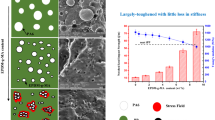Abstract
It is proposed to use the fracture model and the criterion equation of a generalized crackresistance diagram in two-parameter fracture macromechanics to estimate cracking resistance and construct crack-resistance diagrams of polymer composite materials in tension and compression; these fracture model and criterion equation take into account the degree of restraint of deformations near the crack tip in the form of nonsingular T-stresses. A good agreement between the experimental values of normalized stress-intensity factors and a diagram of the calculated crack-resistance of polymer composite materials has been obtained in a wide range of crack lengths using various geometry and arrangements of specimen loading for seven carbon plastics with various orderings produced by different manufacturers using pressure-chamber and infusion methods.
Similar content being viewed by others
References
Liu, S. and Chao, Y.J., Variation of fracture toughness with constraint, Int. J. Fracture, 2003, vol. 124, pp. 113–117.
Xhu, X.K. and Chao, Y.J., Specimen size requirements for two-parameter fracture toughnesstesting, Int. J. Fracture, 2005, vol. 135, pp. 117–136.
Burdeldn, F.M. and Xu, W.G., Effects of biaxial loading and residual stresses on constraint, Int. J. Pressure Vessels Piping, 2003, vol. 80, pp. 755–773.
Seitl, S. and Knersl, Z., Two parameter fracture mechanics: fatigue crack behavior under mixed mode conditions, Eng. Fracture Mech., 2008, vol. 75, pp. 857–865.
Matvienko, Yu.G., Modeli i kriterii mekhaniki razrusheniya (Models and Criteria of Fracture Mechanics), Moscow: Fizmatlit, 2006.
Meliani, H.M., Matvienko, Yu.G., and Pluvinage, G., Two-parameter fracture criterion (Kρ, c-Tef, c) based on notch fracture mechanics, Int. J. Fracture, 2011, vol. 167, pp. 173–182.
Matvienko, Yu.G., Shlyannikov, V.N., and Boychenko, N.V., In-plane and out-of-plane constraint parameters along a three-dimensional crack-front stress field under creep loading, Fatigue Fracture Eng. Mater. Struct., 2013, vol. 36, pp. 14–24.
Meliani, H.M., Azari, Z., Pluvinage, G., and Matvienko, Yu.G., The effective T-stress estimation and crack paths emanating from U-notches, Eng. Fracture Mech., 2010, vol. 77, pp. 1682–1692.
Matvienko, Yu.G., Failure assessment diagrams in structural integrity analysis, in Damage and Fracture Mechanics, Boukharouba, T., Elboujdaini, M., and Pluvinage, G., Eds., Springer, 2009, pp. 173–182.
Matvienko, Yu.G., Effect of biaxial loading onto crack resistance diagram for bodies with cracks and thin cuttings, Probl. Mashinostr. Nadezhn. Mash., 2006, no. 5, pp. 37–41.
Hadj Meliani, M., Pluvinage, G., and Matvienko, Yu.G., Corrosion defect assessment on pipes using limit analysis and notch fracture mechanics, Eng. Failure Anal., 2011, vol. 18, pp. 271–283.
Matvienko, Yu.G. and Pochinkov, R.A., Effect of nonsingular components of Tf-stresses onto plastic deformation zones near the opening mode crack top, Deform. Razrush. Mater., 2012, no. 3, pp. 6–14.
Chernyatin, A.S., Matvienko, Yu.G., and Razumovsk, I.A., A computational tool for estimating stress fields along a surface crack front, Fatigue Fracture Eng. Mater. Struct., 2015, vol. 38, pp. 180–189.
Chernyatin, A.S., Matvienko, Yu.G., and Razumovsky, I.A., Combining experimental and numerical analysis to estimate stress fields along the surface crack front, Frattura ed Integrit Strutturale, 2013, vol. 25, pp. 15–19.
Matvienko, Yu.G., Fracture mechanics approaches in the analysis of strains and fractures of bodies with notches and scotches, J. Mach. Manuf. Reliab., 2008, vol. 37, no. 5, p. 469.
Matvienko, Yu.G., Approaches of fracture mechanics to analysis cut-type tolerance defects, Probl. Prochn., 2010, no. 1, pp. 80–87.
Matvienko, Yu.G., Two approaches to taking nonsingular T-stresses into account in the criteria of fracture mechanics for bodies with notches, J. Mach. Manuf. Reliab., 2011, vol. 40, no. 5, p. 494.
Matvienko, Yu.G., Nonsingular T-stresses in double parametric fracture mechanics problems, Zavod. Lab., Diagn. Mater., 2012, no. 2, pp. 51–58.
Matvienko, Yu.G., Chernyatin, A.S., and Razumovskii, I.A., Numerical analysis of the components of the three-dimensional non-singular stress field at a mixed-type crack tip, J. Mach. Manuf. Reliab., 2013, vol. 42, no. 4, p. 293.
Matvienko, Yu.G., Two-parameter fracture mechanics in contemporary strength problems, J. Mach. Manuf. Reliab., 2013, vol. 42, no. 5, p. 374.
Matvienko, Yu.G., Imitation simulation for analyzing fracture mechanics parameters of nonstandard samples, Zavod. Lab., Diagn. Mater., 2013, no. 10, pp. 50–56.
Matvienko, Yu.G., Modeling and fracture criteria in current problems of strength, survivability and machine safety, J. Mach. Manuf. Reliab., 2014, vol. 43, no. 3, p. 242.
Matvienko, Yu.G., Maximum average tangential stress criterion for prediction of the crack path, Int. J. Fracture, 2012, vol. 176, pp. 113–118.
Matvienko, Yu.G., Analysis of permissible dimensions of cracklike defects based on a diagram of crack-growth resistance, J. Mach. Manuf. Reliab., 2007, vol. 36, no. 2, p. 199
Matvienko, Yu.G., Priimak, O.A., and Elksnin, V.V., A technique for evaluating the permissible depth of an extended surface flaw in a pressurized vessel, J. Mach. Manuf. Reliab., 2007, vol. 36, no. 6, p. 542.
Matvienko, Yu.G., Safety factors in structural integrity assessment of components with defects, Int. J. Struct. Integrity, 2013, vol. 4, no. 3.
Waddoups, M.E., Eisenmann, J.R., and Kaminski, B.E., Macroscopic fracture mechanics of advanced composite materials, J. Composite Mater., 1971, vol. 5, no. 4, pp. 446–454.
Author information
Authors and Affiliations
Corresponding author
Additional information
Original Russian Text © Yu.G. Matvienko, V.V. Konovalov, A.V. Pankov, M.M. Semenova, 2015, published in Problemy Mashinostroeniya i Nadezhnosti Mashin, 2015, No. 6, pp. 42–52.
About this article
Cite this article
Matvienko, Y.G., Konovalov, V.V., Pankov, A.V. et al. Crack-resistance diagrams of polymer composite materials in tension and compression. J. Mach. Manuf. Reliab. 44, 520–530 (2015). https://doi.org/10.3103/S1052618815060102
Received:
Published:
Issue Date:
DOI: https://doi.org/10.3103/S1052618815060102




